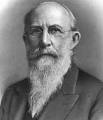| Date | Text | |
|---|---|---|
31 Mar 1903

Richard Pearse flies |
Richard Pearse flies In 1903, New Zealander Richard Pearse (1877-1953) reputedly flew a powered heavier-than-air machine, some nine months before the Wright brothers' more famous and well documented flight. Pearse built a high-wing monoplane powered by his design of a petrol engine. Accounts vary, but his flight was probably 350 yards in the air, though uncontrolled, ending with the machine striking a large hedge. The aircraft was the first to use proper ailerons, instead of the inferior wing warping system that the Wright's used. Also, Pearse's machine had a modern tricycle undercarriage permitting takeoff without ramps or skids. However, his propeller was cruder than the Wrights'. Some sources date his first flight to 31 Mar 1902, and others later. |
|
31 Mar 1903

Ebenezer Butterick |
death Ebenezer Butterick Died 31 Mar 1903 at age 76 (born 29 May 1826). American manufacturer who is regarded as the inventor of graded paper patterns for clothing (1859), first sold in Sterling in Jun 1863. Formerly, a sewer had to enlarge or reduce from one standard pattern to make the required size. As a tailor, Butterick understood the need, and filled it by supplying tissue paper patterns in sizes. At first, these graded sewing patterns were cut and folded by members of his family and sold from their home in Sterling, Massachusetts. The business grew quickly, and in 1869 he moved to New York City. A box of one hundred patterns were sold at a wholesale price of $10 (retail $25). Also in 1869, he founded Metropolitan, a fashion magazine, to promote pattern sales. In the following years, he established subsidiary offices in all important centres in the U.S. and abroad. |